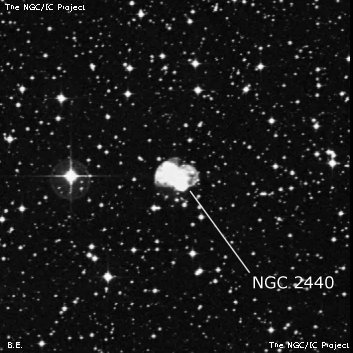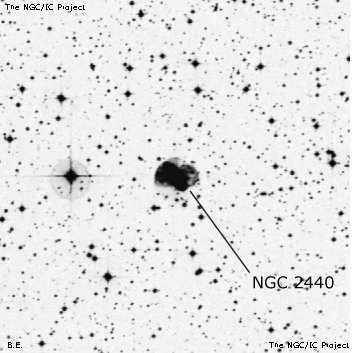NGC/IC Project Restoration Effort
(This is a very very beta version)
NGC2440


Basic Information
Location and Magnitude
Right Ascension: 7:41:55.4
Declination: -18:12:29
Constellation: PUP
Visual Magnitude: 9.4
Historic Information
Discoverer: Herschel W.
Year of discovery: 1790
Discovery aperture: 18.7
Observational
Summary description: planetary, cB, not v well def
Sub-type: PN
Steve's Notes
=====
NGC 2440
48" (2/20/12): the view of this explosive appearing planetary was remarkably detailed at 488x and 814x. The very high surface brightness central region is irregularly shaped with a very ragged periphery, giving the impression that the central region is erupting or bursting. Within the east side of the central portion are two intense condensations or knots, oriented ~N-S, with the southern knot brighter. A third, smaller elongated knot is just west and sits close to the center. The main body is elongated nearly 2:1 SW-NE, roughly 1.1'x0.6', but with an irregular outline. The southwest end of the planetary dims and protrudes out, creating a cup-shaped hollow with a very small brighter knot at its southwest tip. A prominent partial loop or outer wing is attached on the northwest edge of the central section, like a spiral arm, and swings clockwise to the west and slightly south. The eastern portion of the planetary consists of a large complete, irregular loop (darker in the interior), giving the strong appearance of being blown out from the central region.
17.5" (2/14/99): this bi-polar planetary reveals fascinating detail at 380x! The compact high surface brightness inner region is elongated NNW-SSE. Two bright knots comprise both ends and the surface brightness is irregular. The nebulosity is much weaker SW of the main body with a cup-shaped dark "notch" protruding into this central bar. The outer halo is oriented SW-NE with a brighter wing similar to a spiral arm attached at the west edge which swings back towards the south. The outer nebulosity is weaker and less well-defined on the north and NE sides.
13" (2/23/85): very bright and small with a very high surface brightness. This planetary has a double shell structure with an elongated box-shape oriented NW-SE and a fainter shell oriented SW-NE. One or two condensations are visible in the central part. Located 3.0' W of mag 8.4 orange HD 62167.



